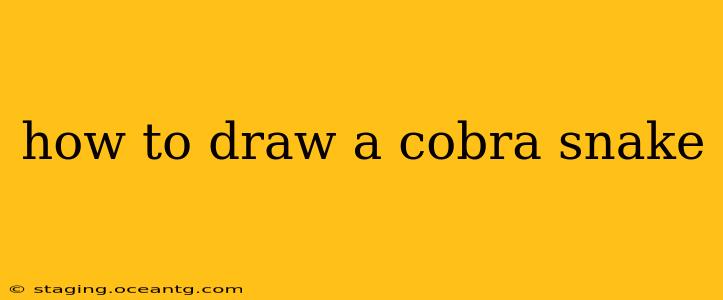Drawing a cobra, with its iconic hood and captivating gaze, can be a rewarding experience. This guide will walk you through the process, from basic shapes to adding intricate details, helping you create a realistic or stylized cobra drawing.
Understanding Cobra Anatomy
Before you begin, it's helpful to understand the key features of a cobra's anatomy. Observe images of cobras to familiarize yourself with their proportions, the shape of their hood, and the position of their eyes and fangs. Note the subtle curves of their bodies and the way their scales overlap. This observation will greatly enhance your drawing.
Step-by-Step Drawing Process
1. Basic Shapes: Start by sketching light, basic shapes to outline the cobra's body. Use an elongated oval for the body, a smaller circle for the head, and a slightly flattened oval for the hood. Position these shapes to suggest the pose of your cobra – coiled, striking, or simply resting.
2. Refining the Head and Hood: Refine the head shape, making it slightly triangular with rounded edges. Add the cobra's eyes – usually round and dark – and the nostrils, which are small and slit-like. The hood is crucial; sketch its distinctive shape, paying attention to the way it expands from the neck. Remember that the hood is not a perfect circle or oval; it has subtle curves and variations.
3. Defining the Body: Sketch the rest of the cobra's body, maintaining a smooth, sinuous curve. Use gentle, flowing lines to suggest the musculature underneath the scales. Avoid making the lines too stiff or rigid. Consider the thickness of the body; it should taper slightly towards the tail.
4. Adding Scales: Cobras have overlapping scales, which give their skin a textured appearance. Don't attempt to draw every single scale; instead, suggest their presence by drawing slightly overlapping, curved lines along the body. Focus more on the larger, more visible scales.
5. Detailing the Head: Add details to the head, including the subtle markings that are characteristic of different cobra species. These can be stripes, spots, or other patterns. Refine the shape of the eyes and nostrils. You can add a forked tongue if you want to make the drawing more lifelike.
6. Finalizing the Drawing: Once you're happy with the basic structure, refine your lines and erase any unnecessary pencil marks. You can add shading to create depth and volume. Pay special attention to the light and shadow on the hood and body. This will significantly enhance the realism of your drawing.
Choosing Your Medium
You can use a variety of mediums to draw a cobra, including:
- Pencils: Graphite pencils offer versatility in creating different shades and textures.
- Charcoal: Charcoal provides a dramatic effect, ideal for creating a dark and intense drawing.
- Colored Pencils: Colored pencils allow you to add color and detail to your drawing, making it more vibrant.
- Digital Drawing: Tablets and software offer flexibility in creating and editing your drawing.
Adding Your Personal Touch
Don't be afraid to experiment and add your own personal touch to your drawing. You can create a stylized cobra, using bolder lines and more simplified shapes, or you can strive for photorealism, paying attention to even the smallest details.
Frequently Asked Questions (FAQ)
What are the key features of a cobra's head I should focus on when drawing?
The key features to focus on are the triangular shape, the position and shape of the eyes (usually round and dark), the small slit-like nostrils, and the distinctive hood which expands from the neck. The hood shape is not uniform; pay attention to its subtle curves.
How do I make my cobra drawing look realistic?
Realistic depiction involves carefully observing and drawing the subtle curves of the body, adding overlapping scale patterns, accurate placement of eyes and nostrils, and most importantly, mastering the shading and light to create volume and depth within your artwork.
What are some common mistakes beginners make when drawing cobras?
Common mistakes include making the body too stiff, neglecting the subtle curves, not paying attention to the scale pattern, and drawing a poorly defined or unrealistic hood. Observing reference images is key to avoiding these pitfalls.
What are some good resources for learning more about drawing snakes?
Many online resources, including tutorials on YouTube and websites dedicated to art instruction, offer valuable lessons and inspiration for drawing various snakes, including cobras. Consider searching for terms like "snake anatomy for artists" or "drawing realistic snakes" to find helpful resources.
By following these steps and practicing regularly, you'll be able to draw impressive and captivating cobra illustrations. Remember, practice is key! The more you draw, the better you'll become.
